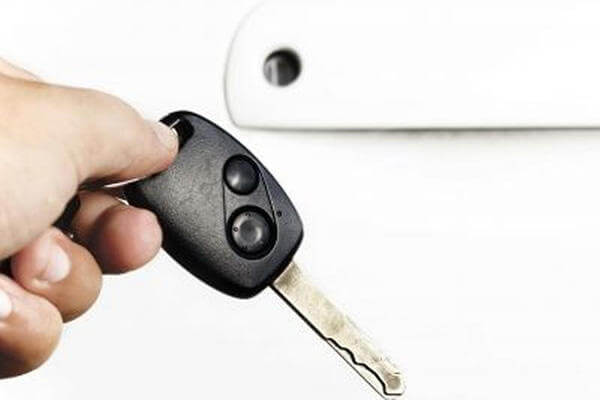The purpose of the ignition system is to ignite, or fire, the spark plugs in order to generate power to run the engine. To do so, the battery sends current to the ignition coil. Then that high voltage goes on to the spark plugs — either through a distributor, if you have an older vehicle, or directly to the sparkplugs, if you have a newer one.
Most vehicles built prior to 1974 use a non-electronic distributor ignition system. Most vehicles built from the mid-1970s to the late 1980s use an electronic distributor ignition system. Today's vehicles use an electronic distributorless ignition system, which, as the name implies, has no distributor at all.
As later sections explain, both types of electronic ignition systems employ electronic parts. Unlike older systems, except for the spark plugs, their components don't need to be replaced unless they break down. The good news is that they tend to be relatively trouble-free. The bad news is that if they do break down, you have to pay a professional to replace them.
Because all types of ignition systems employ spark plugs, you get to explore them first. Read on!
The Spark Plugs
Spark plugs are located in the cylinders of your vehicle. They deliver the spark of voltage to the combustion chamber just when the fuel/air mixture is at the point of greatest compression. The resulting combustion provides the power to propel your vehicle. Figure 5-9 shows you the various parts of a spark plug. You need to get to know them if you want towork on them yourself.

The location of the cylinders varies from one type of engine to another; the order in which the spark plugs fire the fuel in the cylinders differs from one engine to another as well. The next two sections tell you about cylinder sequence and firing order. It's good to know how this works because if the spark plugs aren't firing properly, your engine is as "out-of tune" as an orchestra whose players aren't keeping time. (That's probably why they call it a tune-up.)
Cylinder Sequence
The cylinder sequence of an engine is the order in which the cylinders of the engine are numbered. This sequence varies from one type of vehicle to another, depending on whether it has front-wheel drive or rear-wheel drive and whether it has an in-line engine, with the cylinders lined up in one row,or a V-type engine, with the cylinders in two parallel rows.
Here are cylinder sequences for several types of engines:
Vehicles with front-wheel drive have transverse engines. On both in-line and V-type engines, the cylinders run from one side of the vehicle toward the other. Aside from being set cross-wise, they have the same sequence and firing order as their rear-wheel drive in-line or V-type counterparts (see Figure 5-10).
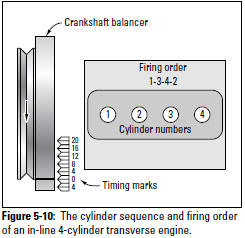
In all U.S.-made in-line 4- and 6-cylinder vehicles with rear-wheel drive, the cylinder nearest the front is called the #1 cylinder. The numbering for the rest of the cylinders (#2, #3, #4, and so on) runs in sequence back toward the firewall at the rear of the engine compartment (see Figure 5-11).
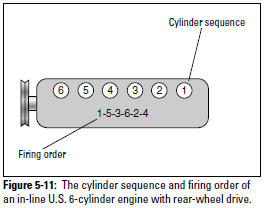
Some foreign automakers reverse the cylinder sequence. As you can see in Figure 5-12, the #1 cylinder is at the rear, near the firewall. If you have a foreign car and no owner's manual, ask your local dealer where your #1 cylinder is.
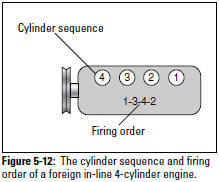
V-8 engines aren't as easy to figure out. Most Ford V-8s with rear-wheel drive have the #1 cylinder in the front on the passenger side of the car. Then cylinders #2, #3, and #4 follow it toward the rear firewall. The #5 cylinder is up front on the driver's side, with cylinders #6, #7, and #8 in sequence going toward therear (see Figure 5-13).
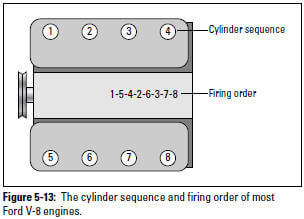
On most other vehicles with V-8 engines and rear-wheel drive, the #1 cylinder is up front on the driver's side, with cylinder #3, #5, and #7 proceeding toward the rear of the vehicle. Then cylinder #2 is up front on the passenger side, with cylinders #4, #6, and #8 following (see Figure 5-14).
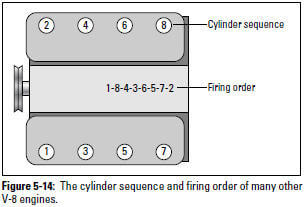
Transverse engines have the same cylinder sequence and firing order as inline engines, and no matter what the engine configuration, the #1 spark plug is always the spark plug in the #1 cylinder (see Figures 5-10, 5-15, and 5-16).
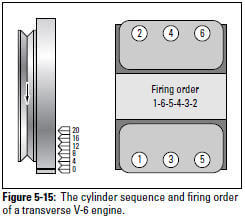
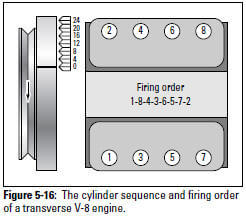
Firing Order
Don't confuse cylinder sequence with firing order. Although your engine may have its cylinders in simple numerical sequence, if the cylinders were fired in that order, the engine would rock violently as first the cylinders on one side (or toward the front) fired in rapid succession, and then the other cylinders did likewise. To avoid this, the firing order is carefully arranged to distribute the shock of combustion evenly throughout the engine.
The cylinders fire in very swift sequence, and the result is a fairly stable engine. The firing order is printed inside each of the engines shown in Figures 5-10 through 5-16. Trace the path of combustion back and forth through each of these engines to see how the shock of combustion is distributed to avoid rocking the engine. And remember, the whole thing happens very rapidly.
Now that I've dealt with the basics, the following sections deal with the two types of electronic ignition systems: the modern ones that no longer have distributors, and the older electronic ignitions with distributors.
